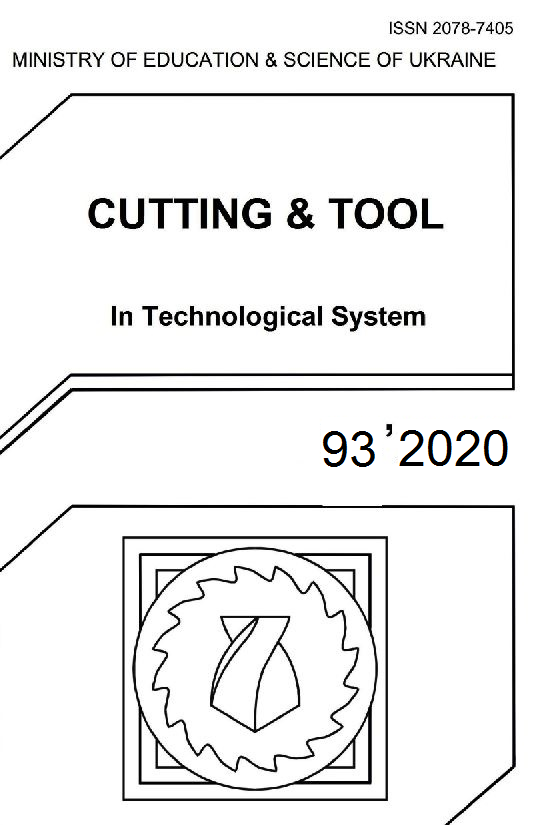ON THE MACHINING OF ALUMINUM ALLOY AL6063 WITH EDM
DOI:
https://doi.org/10.20998/2078-7405.2020.93.09Keywords:
Electrical Discharge Machining, Aluminum alloys, Material Removal Rate, Surface Roughness, pulse-on current and time, White Layer, Analysis of Variance.Abstract
Electrical Discharge Machining (EDM) is a non-conventional machining process, which allows the machining of any electrical conductive material, regardless its mechanical properties, with high dimensional accuracy, and in complex shapes and geometries. EDM widely utilized by modern industry, taking advantage of its unique inherent capabilities. Aluminum alloys find extensive use in numerous applications, and their machining consist an interesting topic, with tangible industrial interest. The current study presents an experimental investigation of machining Al6063 alloy with EDM. A full scale experiment was conducted, with control parameters the pulse-on current and time. The productivity of the process calculated based on the Material Removal Rate (MRR), while the Surface Roughness of the machined surfaces was estimated in terms of Ra and Rt. For these performance indexes Analysis Of Variance was performed and semi-empirical relations that correlate machining parameters with obtained results were proposed. Finally, the cross sections of the specimens were observed in optical microscopy, in order the formation of the White Layer to be studied.References
M.P. Jahan, Electrical Discharge Machining (EDM): Types, Technologies and Applications. New York: Nova Science Publishers, 2015.
E.C. Jameson, Electrical discharge machining. Michigan: Society of Manufacturing Engineers, 2001.
J. E. A. Qudeiri, A. I. Mourad, A. Ziout, M. H. Abidi, and A. Elkaseer, “Electric discharge machining of titanium and its alloys : review,” 2018.
N. M. Abbas, D. G. Solomon, and F. Bahari, “A review on current research trends in electrical discharge machining,” vol. 47, pp. 1214–1228, 2007, doi: 10.1016/j.ijmachtools.2006.08.026.
S. Choudhary and R. Jadoun, “Current advanced research development of electric discharge machining (EDM): a review,” Int. J. Res. Advent Technol., vol. 2, no. 3, pp. 273–297, 2014.
A. A. Khan, “Electrode wear and material removal rate during EDM of aluminum and mild steel using copper and brass electrodes,” Int. J. Adv. Manuf. Technol., vol. 39, no. 5–6, pp. 482–487, 2008, doi: 10.1007/s00170-007-1241-3.
A. Gatto, E. Bassoli, and L. Iuliano, “Performance Optimization in Machining of Aluminium Alloys for Moulds Production: HSM and EDM,” in Aluminium Alloys Theory and Applications, T. Kvackaj, Ed. IntechOpen, 2011.
S. Arooj, M. Shah, S. Sadiq, S. H. I. Jaffery, and S. Khushnood, “Effect of Current in the EDM Machining of Aluminum 6061 T6 and its Effect on the Surface Morphology,” Arab. J. Sci. Eng., vol. 39, no. 5, pp. 4187–4199, 2014, doi: 10.1007/s13369-014-1020-z.
A. Pramanik, A. K. Basak, M. N. Islam, and G. Littlefair, “Electrical discharge machining of 6061 aluminium alloy,” Trans. Nonferrous Met. Soc. China (English Ed., vol. 25, no. 9, pp. 2866–2874, 2015, doi: 10.1016/S1003-6326(15)63912-7.
P. Srikanth and C. P. Kumar, “Electrical discharge machining characteristics of metal matrix composites-A Review,” Int. J. Sci. Res., vol. 4, no. 6, pp. 1385–1394, 2015, [Online]. Available: http://www.sciencedirect.com/science/article/pii/S0924013600008232.
B.C. Kandpal, J. kumar, and H. Singh, “Machining of Aluminium Metal Matrix Composites with Electrical Discharge Machining - A Review,” Mater. Today Proc., vol. 2, no. 4–5, pp. 1665–1671, 2015, doi: 10.1016/j.matpr.2015.07.094.
L. Selvarajan, J. Rajavel, V. Prabakaran, B. Sivakumar, and G. Jeeva, “A Review Paper on EDM Parameter of Composite material and Industrial Demand Material Machining,” Mater. Today Proc., vol. 5, no. 2, pp. 5506–5513, 2018, doi: 10.1016/j.matpr.2017.12.140.
N. Radhika, A. R. Sudhamshu, and G. K. Chandran, “Optimization of Electrical Discharge Machining Parameters of Aluminium Hybrid Composites Using Taguchi Method,” J. Eng. Sci. Technol., vol. 9, no. 4, pp. 502–512, 2014.
Downloads
Published
Issue
Section
License
Copyright Notice
Authors who publish with this Collection agree to the following terms:
1. Authors retain copyright and grant the Collection right of first publication with the work simultaneously licensed under a Creative Commons Attribution License that allows others to share the work with an acknowledgement of the work's authorship and initial publication in this Collection.
2. Authors are able to enter into separate, additional contractual arrangements for the non-exclusive distribution of the Collection's published version of the work (e.g., post it to an institutional repository or publish it in a book), with an acknowledgement of its initial publication in this Collection.
3. Authors are permitted and encouraged to post their work online (e.g., in institutional repositories or on their website) prior to and during the submission process, as it can lead to productive exchanges, as well as earlier and greater citation of published work.

